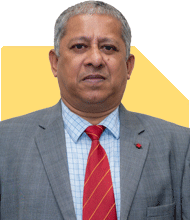44-Year-Old With 8.5 Cr. Invested, Aiming for Early Retirement: Is It Feasible?
Ramalingam Kalirajan |8319 Answers |Ask -Follow
Mutual Funds, Financial Planning Expert - Answered on Nov 04, 2024
He has an MBA in finance from the University of Madras and is a certified financial planner.
He is the director and chief financial planner at Holistic Investment, a Chennai-based firm that offers financial planning and wealth management advice.... more

Hi I am 44 years old and have 5 cr in FD,s , 1.5 cr in MF with over 1 lac monthly SIP investing in flexi cap , balanced fund , large caps, mid cap and small cap funds with an investment horizon of 10 years. Have 20 lacs in stocks , investing 7 lacs annually in annuity plan HDFC sanchay, and around 4 lacs in various insurance policies for tax free(ICICI and sriram) returns. Also I have started a sip(2k each ) for my 2 kids aged 5 and 12 in mid cap funds ..looking to increase this every year time horizon 30 years .. I would like to retire now and am looking at a swp of atleast 3-4 lacs per month after 6 years from my MF's. And annuity returns . Till that time my FD,s will also mature.. Would it be possible to earn 4 lacs through swp after 6 years...and I would like to build a corpus of around 30 cr after 15 years.. please suggest if I am on the right track.. Would it be possible to generate
1. Evaluating Your Mutual Fund Investments for SWP Needs
Your current SIPs are in flexi-cap, balanced, large-cap, mid-cap, and small-cap funds, which align well with your growth and SWP goals. Here’s how these investments can work towards achieving your objectives:
High-Return Potential in Equity Funds: Over 10 years, your equity-oriented funds (large-cap, mid-cap, small-cap) can provide growth, supporting your monthly withdrawal goals.
Balanced Funds for Stability: Balanced funds add stability to your portfolio, reducing market volatility's impact on withdrawals.
Flexi-Cap Diversification: Flexi-cap funds enhance flexibility, adjusting across large, mid, and small-cap stocks as per market conditions.
2. Systematic Withdrawal Plan (SWP) for Regular Monthly Income
Generating a SWP of Rs 3-4 lakhs after six years is achievable with a focused approach. Here’s a breakdown:
Establish a SWP Strategy: With a strong equity base, an SWP from your mutual funds can generate a monthly income. Reinvesting dividends or interest could further enhance your returns.
Aligning Fund Selection with SWP: Large-cap and balanced funds can be core SWP assets, as they are less volatile and provide stable growth.
Plan for Market Fluctuations: Market fluctuations could impact SWP withdrawals. You may consider moving a portion to debt funds closer to retirement for stability.
3. Increasing Your Kids' SIPs with Long-Term Vision
For your children, a 30-year horizon in mid-cap funds is promising. Increasing their SIPs regularly will amplify the impact of compounding:
Annual SIP Increase: Aim to raise the SIP amount yearly. Gradual increases, even by a few thousand rupees, can yield significant growth over 30 years.
Mid-Cap Growth Potential: Mid-cap funds can provide substantial returns over the long term. Diversifying with large-cap or flexi-cap funds could add stability.
Reinvestment in Tax-Efficient Funds: As your children reach different financial milestones, you can gradually move to tax-efficient funds or low-risk options for stability.
4. Reassessing Fixed Deposits and Annuities for Wealth Maximisation
Currently, a significant portion of your investments is in FDs and an annuity plan. Let’s evaluate the pros and cons of these investments:
Fixed Deposits for Short-Term Stability: FDs are stable but offer limited returns compared to mutual funds. Upon maturity, consider reinvesting in a mix of equity and debt mutual funds for higher growth potential.
Annuity Limitations: Annuity plans provide steady income but typically have lower returns. Since annuity returns are fixed, they may not keep up with inflation over the long term.
Shifting Focus to Equity Mutual Funds: Reinvesting your FD maturity and annuity corpus into mutual funds could help you achieve your Rs 30 crore target faster.
5. Optimising Insurance Plans for Better Returns
Your insurance plans provide tax-free returns, but it’s essential to assess whether they align with your overall goals. Here’s a perspective on your ICICI and Shriram policies:
Limited Growth in Traditional Insurance: Traditional insurance offers tax-free returns but often has limited growth potential.
Consider Surrendering for Higher Growth: If these policies underperform compared to mutual funds, you may consider surrendering them. Reinvesting in mutual funds could yield higher long-term returns.
Insurance for Protection, Not Investment: Moving towards term insurance for coverage and mutual funds for investment may be a more effective approach.
6. Building a Rs 30 Crore Corpus Over the Next 15 Years
Achieving a Rs 30 crore corpus in 15 years will require a strategic blend of high-growth investments. Here’s a suggested approach:
Focus on Equity Funds for Growth: Equity funds, especially mid and small-cap, can accelerate your portfolio growth. Increasing SIPs over time will enhance your corpus.
Reinvest Maturity Proceeds: As your FDs mature, reinvest them into equity and balanced mutual funds to benefit from compounding.
Balance with Debt Funds in Later Years: As you near your goal, gradually move funds to debt mutual funds. This will reduce risk and protect the corpus for withdrawal.
7. Disadvantages of Index Funds and Direct Plans
Although index funds and direct funds are popular, there are better options for your high-growth goals:
Index Funds’ Growth Limitation: Index funds simply track the market and don’t aim for higher returns. Actively managed funds, on the other hand, can outpace the market.
Direct Plans Lack Professional Guidance: With direct plans, there’s no personalised guidance. Investing through a Certified Financial Planner ensures regular monitoring and timely adjustments.
8. Tax Considerations on Mutual Fund Withdrawals
Tax-efficient planning is essential for maximising SWP returns:
Equity Fund Taxation: For equity mutual funds, LTCG over Rs 1.25 lakh is taxed at 12.5%. STCG is taxed at 20%. Plan withdrawals to stay within these limits for minimal tax impact.
Debt Fund Taxation: Debt mutual funds are taxed according to your tax slab. Using a mix of debt and equity can balance returns with lower taxes.
Final Insights
Your diversified portfolio places you on a solid path to a secure retirement and wealth creation. Increasing SIPs for your kids, reinvesting maturing FDs, and focusing on mutual funds over insurance and annuities will strengthen your approach. Working closely with a Certified Financial Planner will keep your investments aligned with your Rs 30 crore goal, ensuring a steady retirement income and lasting legacy.
Best Regards,
K. Ramalingam, MBA, CFP,
Chief Financial Planner,
www.holisticinvestment.in
https://www.youtube.com/@HolisticInvestment
Best Regards,
K. Ramalingam, MBA, CFP,
Chief Financial Planner,
www.holisticinvestment.in
https://www.youtube.com/@HolisticInvestment
You may like to see similar questions and answers below
Ramalingam Kalirajan |8319 Answers |Ask -Follow
Mutual Funds, Financial Planning Expert - Answered on May 13, 2024
Ramalingam Kalirajan |8319 Answers |Ask -Follow
Mutual Funds, Financial Planning Expert - Answered on Sep 17, 2024
Milind Vadjikar |1206 Answers |Ask -Follow
Insurance, Stocks, MF, PF Expert - Answered on Apr 15, 2025
Dr Nagarajan J S K |367 Answers |Ask -Follow
NEET, Medical, Pharmacy Careers - Answered on May 05, 2025
Prof Suvasish Mukhopadhyay |615 Answers |Ask -Follow
Career Counsellor - Answered on May 05, 2025
Dr Dipankar Dutta |1197 Answers |Ask -Follow
Tech Careers and Skill Development Expert - Answered on May 05, 2025
Radheshyam Zanwar |1599 Answers |Ask -Follow
MHT-CET, IIT-JEE, NEET-UG Expert - Answered on May 05, 2025
Radheshyam Zanwar |1599 Answers |Ask -Follow
MHT-CET, IIT-JEE, NEET-UG Expert - Answered on May 05, 2025

EEE (Electrical and Electronics Engineering) at IIIT Gwalior (ABV-IIITM) can be a decent choice. But if you're strictly interested in core electrical engineering, other colleges (like NITs) might be a better option because not many EEE-core companies visit the campus in comparison to CS/IT branches. Finally, if your interest is strictly in core EEE, IIIT Gwalior might not offer as many labs or core recruiters as older NITs or IITs with stronger electrical departments.
Follow me if you like the reply. Thanks
Radheshyam
If not followed, pl follow and like. Thanks
Radheshyam Zanwar |1599 Answers |Ask -Follow
MHT-CET, IIT-JEE, NEET-UG Expert - Answered on May 05, 2025
Prof Suvasish Mukhopadhyay |615 Answers |Ask -Follow
Career Counsellor - Answered on May 05, 2025

Prof Suvasish Mukhopadhyay |615 Answers |Ask -Follow
Career Counsellor - Answered on May 05, 2025

Mihir Tanna |1052 Answers |Ask -Follow
Tax Expert - Answered on May 05, 2025
Samraat Jadhav |2269 Answers |Ask -Follow
Stock Market Expert - Answered on May 05, 2025






















